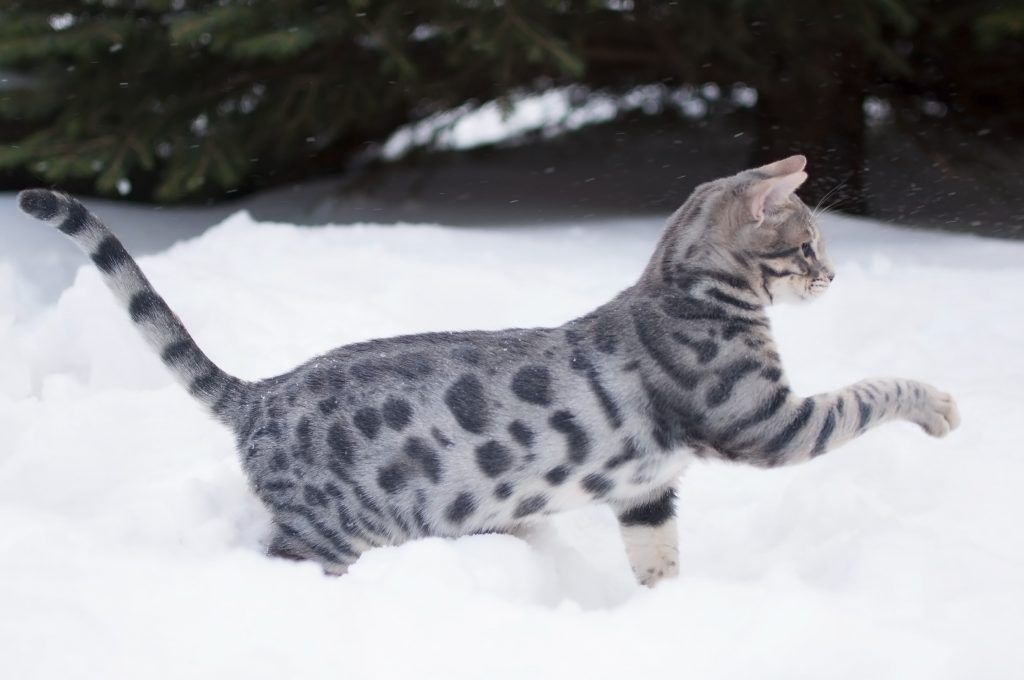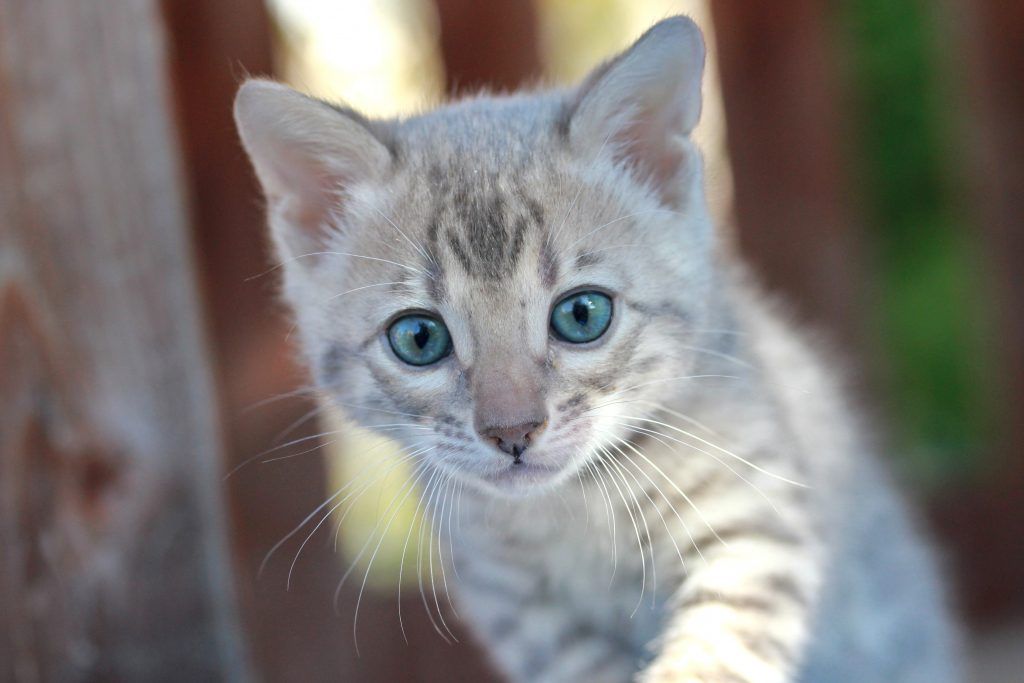Blue Bengals are a rare and stunning variety of the Bengal breed, which is a cross between a domestic cat and an Asian leopard cat. In this blog post, we will explore the origin, characteristics, and personality of the blue Bengal cat, as well as some unique facts about this amazing feline.
Where did Blue Bengal Cats Come From?
The Bengal cat breed was developed in the 1970s by Jean Mill, an American breeder who wanted to create a domestic cat with the wild appearance and temperament of a leopard. She crossed a female Asian leopard cat with a male domestic cat, and the resulting kittens were the first generation of Bengals. These kittens were then bred with other domestic cats, such as Abyssinians, Egyptian Maus, and Ocicats, to produce more diverse and desirable traits.
The original brownish-orange color remains the most common and popular for this breed, but other colors appeared as well, including the stunning blue Bengal we’re talking about.

The blue color in Bengals is a result of a mutation in the gene that controls the production of melanin, the pigment that gives color to the fur, skin, and eyes. Instead of blocking black pigment, this gene dilutes it, resulting in a grayish-blue hue. The first blue-colored Bengal was born in the 1980s, but it was not until the 1990s that blue Bengals became more widely recognized and accepted by breeders, if not by the various cat associations.
Blue Gene: Recessive or Dominant?
The blue coat gene in Bengals is recessive, meaning that both parents must carry it in order to produce a blue kitten.
If a Bengal cat inherits only one copy of the blue gene, it will not show the blue color, but what it will do is carry the gene and the possibility of passing it on to its offspring down the road.
Similarly, if two visual blue Bengals are bred together, all of the kittens will be blue. They will still vary in shade, though.
The blue gene is not specific to the Bengal breed, and it’s found in many other cat breeds as well, such as the British Shorthair, the Russian Blue, and the Chartreux.
However, the blue gene is considered rare in Bengals, and only a few breeders specialize in producing them.
Is Blue a Rare Color in Bengals?
Yes, blue is a rare color in Bengals and is one of the more difficult colors to breed. This is because the blue gene is recessive and is also linked to the gene for the spotted pattern, which is the most common and desirable pattern in Bengals. This means that in order to produce a blue Bengal, both parents must be spotted and carry the blue gene. Sounds simple, right? Not quite. Another common pattern in Bengal cats is marbled. Therefore, if one parent is marbled and carries the blue gene, the chances of producing a blue Bengal are very low.
Blue Bengals are considered to be very exclusive and sought-after by cat lovers.
Another factor that makes blue Bengals rare is the fact that the blue color is not always easy to identify. The blue color can range from a light silver-gray to a dark slate-gray, depending on the amount of melanin in the fur. The blue color can also be affected by the lighting, the background, and the contrast of their markings. Some blue Bengals may appear to be brown or charcoal in certain conditions, and some may have a warm or cool undertone to their coat. So it’s wise to consult a reputable breeder or a Bengal expert to confirm the true color of a blue Bengal.
Popularity of Blue Bengals
Despite their rarity, or perhaps because of it, blue Bengals are highly popular among cat enthusiasts who appreciate their elegant appearance. They have the same striking features as other Bengals, such as large almond-shaped eyes, prominent whisker pads, a muscular body, and the thick tail. However, their blue coat adds a touch of sophistication and mystery to their look, definitely making them stand out from the crowd.
Most cats have their playful moments, but bengals may have more than other breeds. Watch the adorable blue bengal named Fendi as he rolls around on the floor playing with a hair tie. As cute as it may be and it certainly makes for a great video, you definitely shouldn’t let cats play with hair ties, at least unsupervised.
How Much is a Blue Bengal Cat?
Blue Bengal cats are typically more expensive than other Bengals, because they are rare and hard to breed. The average price of a blue Bengal cat can range from $1,500 to $5,000, making them one of the most expensive cats, just shy of a Khao Manee.
If you are interested in buying a blue Bengal cat, it is important to do your research and find a reputable breeder who can provide you with health certificates and genetic tests when applicable.
If at all possible, try to visit the breeder’s facility and meet the parents and the kittens in person, to ensure that they are healthy, well-socialized, and well-cared for. And be prepared to provide your blue Bengal cat with a stimulating and enriching environment, as well as regular grooming, veterinary care, and attention.
Do Blue Bengals Make Good Cats?
Blue Bengals are amazing cats if you’re looking for a unique, exotic, and intelligent companion. They are not necessarily good for someone looking for a quiet, low-maintenance, or independent cat, as they are very energetic, vocal, and demanding. Blue Bengals require a lot of mental and physical stimulation, as well as social interaction, to keep them happy and healthy. They also need a lot of space, as they are very active and agile, and they like to climb, jump, and run.

But blue Bengals are not aggressive or destructive either, although they can sometimes be mischievous and naughty when bored. They may get into trouble by opening cabinets, knocking things over, or stealing items and can show some wild behaviors, such as hunting, stalking, or spraying.
So it’s important to train and socialize your blue Bengal cat from an early age, and to provide them with plenty of toys, scratching posts, and cat trees. You should also consider getting another cat or a dog to keep your blue Bengal company, as they are very sociable and enjoy having a playmate.
Unique Facts About Blue Bengals
Here are some fun and intriguing facts about blue Bengals that you might not know:
- Blue Bengals are not actually blue, but gray. The term “blue” is used to describe the dilution of the black pigment in their fur, which gives them a bluish-gray hue.
- Blue Bengals are not a separate breed, but a color variation of the Bengal breed. They have the same ancestry, characteristics, and personality as other Bengals, except for their coat color.
- Blue Bengals are not hypoallergenic, but they are considered low-shedders and easy to groom. They have a short, sleek, and silky coat that does not require much brushing or bathing. However, they may still trigger allergies in some people who are sensitive to cat dander or saliva.
- Blue Bengals are not albinos, but they may have blue eyes. The blue gene does not affect the eye color, which is determined by another gene. Most blue Bengals have green, yellow, or gold eyes, but some may have blue eyes, especially if they have the snow or lynx point pattern. Blue-eyed blue Bengals are very rare and beautiful.
- Blue Bengals are not cold, but they can feel colder to the touch. The blue gene affects the production of melanin, which is not only responsible for the color of the fur, but also for the regulation of body temperature. Causing blue Bengals to potentially have a lower body temperature than other Bengals, and they may feel cooler to the touch. But, this does not mean that they are cold or uncomfortable, as they can adjust their temperature by seeking warmth or shade as needed.























